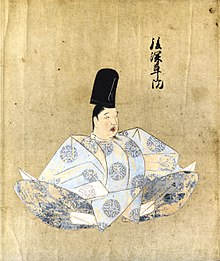| Emperor Go-Fukakusa 後深草天皇 | |||||
|---|---|---|---|---|---|
 | |||||
| Emperor of Japan | |||||
| Reign | 16 February 1246 – 9 January 1260 | ||||
| Enthronement | 29 March 1246 | ||||
| Predecessor | Go-Saga | ||||
| Successor | Kameyama | ||||
| Shōgun | Kujō Yoritsugu Prince Munetaka | ||||
| Born | 28 June 1243 Imadegawa-dono (今出川殿), Heian kyō (Japan) | ||||
| Died | 17 August 1304 (aged 61) Nijo-Tominokoji-dono (二条富小路殿), Heian kyō | ||||
| Burial | Fukakusa no kita no Misasagi (深草北陵) (Kyoto) | ||||
| Spouse | Fujiwara no Kimiko | ||||
| Issue more... | |||||
| |||||
| House | Imperial House of Japan | ||||
| Father | Emperor Go-Saga | ||||
| Mother | Fujiwara no Kitsushi | ||||
| Signature |  | ||||
Emperor Go-Fukakusa (後深草天皇, Go-Fukakusa-tennō, 28 June 1243 – 17 August 1304) was the 89th emperor of Japan, according to the traditional order of succession. This reign spanned the years 1246 through 1260.[1]
This 13th-century sovereign was named after the 9th-century Emperor Ninmyō[2] and go- (後), translates literally as "later", and thus he could be called the "Later Emperor Fukakusa". The Japanese word go has also been translated to mean the "second one"; and in some older sources, this emperor may be identified as "Fukakusa, the second", or as "Fukakusa II".
- ^ Titsingh, Isaac. (1834). Annales des empereurs du Japon, pp. 248–255; Varley, H. Paul. (1980). Jinnō Shōtōki. pp. 231–232.
- ^ Varley, p. 237; n.b., Fukakusa was an alternate name for Emperor Ninmyō.